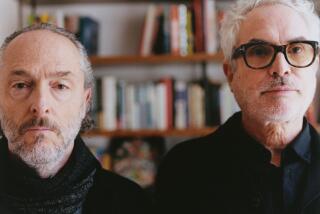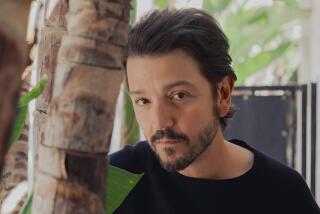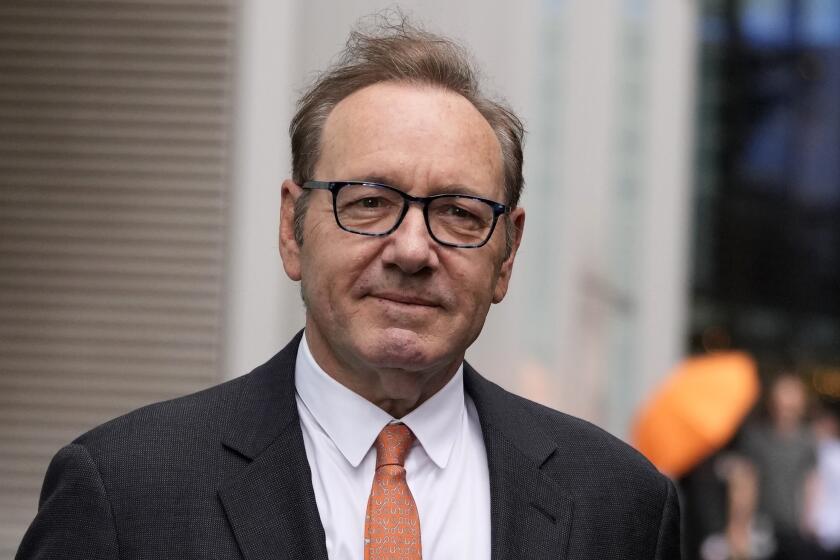Alfonso Cuarón and son Jonás bound by words in ‘Gravity’
Being the son of an obsessive filmmaker means your life already has a destiny, whether intended or not. That was certainly the case for Jonás Cuarón, the eldest son of Mexican filmmaker Alfonso Cuarón.
Young Jonás spent weeks on his father’s first feature, 1991’s “Love in the Time of Hysteria.” He had a small role in his father’s second film, 1995’s “A Little Princess,” and attended school on the Warner Bros. lot in Burbank. “He was so happy,” remembered Alfonso. “He was the only boy surrounded by 20 girls.”
Jonás remembers his father regaling him constantly with stories of the films he wanted to make. “He was probably practicing his pitches on me,” Jonás recalls now with a laugh.
It was a childhood rich in the intricacies of moviemaking. Yet Alfonso was surprised when Jonás turned his senior thesis from Vassar College into a feature film made entirely of still photographs and said he wanted to be a filmmaker.
Said Alfonso, “When he showed me it, I said, ‘I didn’t know you wanted to do that,’ and he said, ‘I grew up going to movie sets. You take me to the movies all the damn time, talking about movies and telling me the stories you want to do. All of your friends are directors and they are always around talking about movies. What did you expect?’”
Still, neither could have expected that this would lead eventually to a vital and unusual collaboration. Jonás is the 30-year-old co-writer of “Gravity,” which he penned in concert with his 51-year-old father, the filmmaker with a rich career on such disparate movies as “Y Tu Mamá También,” “Children of Men” and “Harry Potter and the Prisoner of Azkaban.” “Gravity,” which opens Oct. 4, marks the second pairing for the two but the first to be produced.
After years of painstaking work, Alfonso and Jonás have come together at the Chateau Marmont in West Hollywood to talk about their collaboration on one of the season’s most anticipated films.
The fruit of their labor is a film that is at once action-packed and meditative, tracking the journey of two wayward astronauts (Sandra Bullock and George Clooney) set adrift in space. Warner Bros.’ “Gravity” combines Alfonso’s grand, creative visuals with Jonás’ minimalist screenwriting style that prefers to ground emotion in action rather than dialogue.
The film evolved from some of the duo’s favorite movies: Steven Spielberg’s 1971 television movie “Duel,” 1985’s “Runaway Train” starring Jon Voight and Eric Roberts, and Robert Bresson’s 1956 film “A Man Escaped” — movies the two discussed during Jonás’ formative years.
“We wanted to do something where you are in a constant ride, but it’s a ride that’s emotional — with adrenaline on one hand but on the other a simple narrative where we can still juggle thematics without stopping to develop them,” said Jonás, who resembles his father physically but is more reserved in his demeanor.
Those simple principles could have produced a simple, straightforward project, yet it was a long and winding route before “Gravity” finally took off.
Try, try again
Both Cuaróns were in London in 2009 prepping for their initial collaboration, a small indie European road trip movie called “A Boy and His Shoe” that Alfonso was to direct with Charlotte Gainsbourg and Daniel Auteuil starring. But in a matter of days the financing fell apart and the duo realized that unless they dramatically changed the entire conceit of the film, it was time to move on.
“It became clear that at that point in the marketplace, to put together a small movie was very difficult,” said Alfonso. “So we thought, ‘OK, let’s change the canvas.’”
Cuarón’s longtime cinematographer and friend Emmanuel Lubezki (“The Tree of Life,” “Children of Men”) remembers how frustrated everyone was at the time. “We were really upset that a tiny movie had fallen apart especially after we had done ‘Harry Potter,’” he said. “Alfonso had a little bit of power at that time to put it together. He had a great cast, and he was really upset. That’s when he said, ‘[I’m finished with] indie movies; I’m going to make a big studio movie.’”
You can’t find a bigger canvas than space.
That afternoon Jonás and Alfonso say they came up with the concept for “Gravity” — a story centered primarily on one character’s adversities (Bullock), which reflected her current professional strife. Within a couple of days the duo had mapped out the story line.
Over the next month, via long all-night sessions over Skype, the father and son banged out a screenplay, often on different sides of the globe. “It was horrible,” said Jonás, who was in Madrid renting a home from a friend while his father was in Mexico. “I would do all these all-nighters and from darkness my windows would turn bright. It would be the opposite on his side. From light, it would go dark.”
The duo’s objective was to take what could be pure escapist fare and enhance it with themes of survival and finding meaning after loss. “That primal fear — of floating into the void — that’s something that’s a primal fear in daily life, the fear of losing ground,” Alfonso said.
For Alfonso, who is now a grandfather thanks to Jonás’ two young children, the process was another opportunity to see his grown son, who resides primarily in Mexico City. (The director has two younger children, ages 10 and 8, who live in Europe with their mother, actress Annalisa Bugliani. Jonás’ mother is actress Mariana Elizondo.)
“For me, it’s perfect,” he said. “He’s grown up. He has his own life. He doesn’t care about Dad. He never calls.”
“But then we are writing, and I have to call every day. I have to spend hours on Skype with him,” lamented Jonás, who would do most of the typing during their all-night sessions before turning it over to his father when the sun came up. (Alfonso previously collaborated with his brother Carlos, who co-wrote “Y Tu Mamá” and wrote and directed “Rudo y Cursi,” which Alfonso produced.)
The hope was to get filming in the next three months — the project, though larger than their road trip collaboration, was still imagined at the time as a “small space movie.”
“Alfonso said it’s going to be simple,” Lubezki recalls, “we have only one actor. We build the rocket and then with three guys we can shoot the movie. But that is Alfonso. And of course, $80 million later, five years later and hundreds and hundreds and hundreds of people working on it, we have this movie.”
Months turned into years because the technology had to catch up with Alfonso’s vision. Not content to work with wires and other tricks that have been used in the past to re-create space, Alfonso and company spent four years developing proprietary technology to mimic weightlessness — a process that Warner Bros. supported, investing in the development of the technology and staying committed to Cuarón’s vision, even though it wasn’t shown a frame of the film until six months after the director finished shooting.
Thus the film was created through heavy use of computer graphics. The production worked with visual effects company Framestore on a soundstage outside of London. Special built contraptions allowed the actors to be moved around just enough to simulate zero gravity while the lights and cameras did most of the heavy lifting.
An additional challenge came with Alfonso’s desire to draw out his shots. Close to 60% of the film is made of just 12 long, seamless takes.
The result is a film that early reviews have lauded for both its visual achievement and its gripping storytelling. Entertainment Weekly is astonished by the film’s “hypnotic seamlessness.” The Village Voice calls it “remarkable because it’s both a spectacle and a platform for the performers.”
A learning experience
What has surprised the father-and-son duo is how the experience has changed their personal relationship.
“I’ve learned a lot of things from him,” Jonás said, “but one is that when you sit down to plan a movie, you sit down to plan a movie you would like to see.”
Jonás, according to his father, was easily bored and kept pushing his dad to move the action forward faster and let the audience connect to the characters through the action.
“I would try to intellectualize the whole thing,” Alfonso said, “and he would say, ‘Well, whatever, that’s boring.’ And that was frustrating at points, but it forced us to shape it another way. I had to entertain my son.”
“It was a true collaboration where Jonás was truly Alfonso’s equal,” said the film’s producer, David Heyman, who previously worked on “Harry Potter” and counts the director as godfather to one of his children. “He likes to say he was just another writer, but being Alfonso’s son there was that ability to bring a directness and an honesty to their communication that enhanced Alfonso’s work.”
Blake Edwards co-wrote two of the 1980s “Pink Panther” movies with his son Geoffrey, and Irish director Jim Sheridan collaborated with daughters Naomi and Kirsten on the 2002 Oscar-nominated script “In America.” But there are few parent-child writing collaborations in Hollywood today.
Alfonso says that Jonás helped rejuvenate his passion for pure cinema. The director, known for his painterly visual mastery — his single-shot action sequence in “Children of Men” has been particularly lauded — admits that he had been muddled in midcareer.
“He helped me refine it,” Alfonso said. “I always had it, but then you start making your films and shaping your career, there is a point where the stuff you learn and the baggage you’ve accumulated weighs you down. It’s good to strip all that away.”
Jonás, whom Heyman describes as having a “quiet confidence,” is pushing his stripped-down narrative approach forward on his own now, directing the indie feature “Desierto,” based on a script he wrote. Set to begin filming in Baja in January, the thriller set on the Mexican border will star Alfonso’s star from “Y Tu Mamá También,” Gael García Bernal.
Now it’s Alfonso who will wait for Jonás to finish before the duo can collaborate again on a project they are in the beginning stages of writing together.
“If Mr. Important Man gets some time,” Cuarón senior said with a laugh, “we can work.”
More to Read
Only good movies
Get the Indie Focus newsletter, Mark Olsen's weekly guide to the world of cinema.
You may occasionally receive promotional content from the Los Angeles Times.










